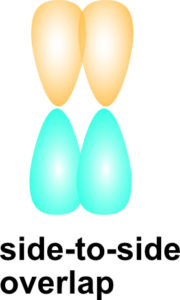Recall that sigma bonds are single bonds with the electron density being concentrated along the internuclear axis. With multiple bonds, we need to consider pi bonds. A pi (π) bond is the result of two p orbitals overlapping sideways as shown below. A pi bond is weaker than a sigma bond.
A double bond is composed of one sigma bond and one pi bond. A triple bond is composed of one sigma bond and two pi bonds. Looking at ethylene, H2C=H2 we see it has a double bond.
Each carbon has a trigonal planar electron pair geometry. Both carbons are sp2 hybridized. The 1s orbital of each hydrogen atom overlaps with an sp2 hybridized orbital of carbon. The sigma bond between the two carbons is formed by end to end overlap of sp2 hybridized orbitals. The pi bond is formed by side to side overlap of unhybridized p orbitals on carbon. The electrons in the pi bond lie above and below the axis of the sigma bond.
We see that ethylyne, HC≡CH has a triple bond. A triple bond has one sigma bond and two pi bonds.
Each carbon has a linear electron pair geometry. The hybridization for the carbon atoms is linear. The sigma bond between the two carbons is formed by the overlap of two sp hybridized orbitals. The pi bonds are formed by side to side overlap of two unhybridized p orbitals. A 1s orbital of each hydrogen overlaps an sp hybridized orbital of carbon. You can think of the electrons in the two pi bonds as being in a cylindrical region about the planar axis.
Worksheet: Valence Bond Theory and Hybridization
Exercises
Exercise 1. How many pi bonds in NCl3?
Check Solutions/Answers to Exercise 1
Exercise 2. How many pi and sigma bonds in CO2?
Check Solutions/Answers to Exercise 2
Exercise 3. How many pi and sigma bonds in ClCN?
Check Solutions/Answers to Exercise 3
Exercise 4. Indicate which orbitals overlap for each bond in the H2C=CCl2.
Check Solutions/Answers to Exercise 4
Exercise 5. What is the hybridization of the non-terminal bonds in CHOOH? Indicate which orbitals overlap to form the bonds.
Check Solutions/Answers to Exercise 5
Back to Bonding Models for Covalent Compounds
Back to General Chemistry 1 Study Guides
Back to Home Page

